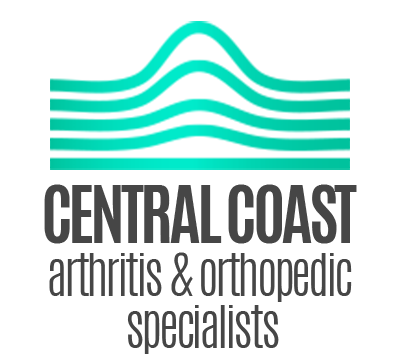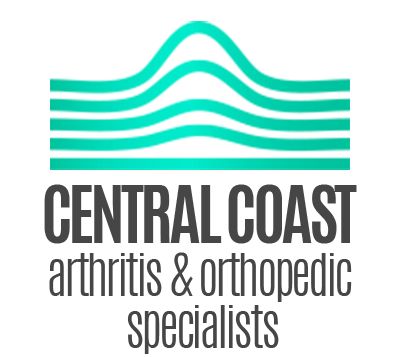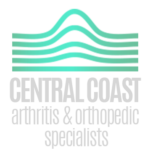Shoulder arthroscopy
Revolutionary treatments for rotator cuff and labrum injuries
Rotator cuff and labrum injuries are among the most common injuries that I treat at Central Coast Arthritis and Orthopedic Specialists. There are many types of rotator cuff and labrum injuries, and most occur by either accidents or repetitive motion. In all cases, the injuries are painful and severely impede active and pain-free living.
Treating rotator cuff injuries non-surgically is always my goal, but if conservative treatments are not an option, many patients opt for arthroscopic shoulder surgery. Luckily, treatment for rotator cuff injuries and labrum injuries has come a long way in the past decade, and the advanced techniques I utilize minimize pain and recovery time after surgery and even lets patients be in and out of my office in just a few hours.
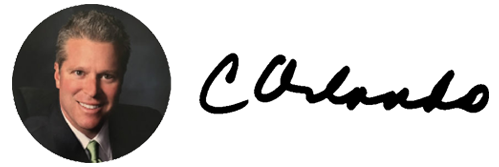
Carlo Orlando, MD.
ORTHOPEDIC SURGEON
Always there to care
Book Your Appointment
Shoulder Page - Book
We will get back to you as soon as possible.
Please try again later.
What is the rotator cuff?
The rotator cuff is made up of four muscles that cover the head of the shoulder, forming the tendons that keep the ball of the shoulder joint secured within the socket. The rotator cuff shares the job of stabilizing the shoulder with the labrum, which connects the shoulder and the bicep. This means that some shoulder injuries involve or impact the bicep as well.
What is the labrum?
The labrum is a piece of soft cartilage and is located in the socket-shaped joint in the shoulder bone. The labrum cups the ball-shaped joint at the top of the upper arm, connecting the two joints. The rotator cuff helps the labrum keep the ball in the socket, allowing the upper arm to rotate.
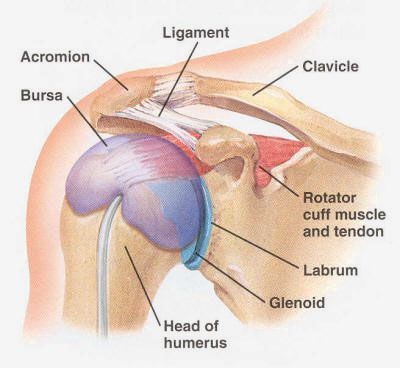
Common rotator cuff and labrum injuries
What is a rotator cuff tendon tear
A rotator cuff tendon tear is a tear in the actual tendon of the shoulder, usually the supraspinatus tendon that is located at the top of the shoulder. The tear can either be a partial tear, where the tendon is still connected to the bone, or a full thickness tear, where the tendon completely tears away from the bone.
Rotator cuff tendon tear causes & symptoms
These types of tears are usually degenerative and occur over time from repetitive overhead motions, though acute tears can occur when a person falls with their arm extended or if they lift a heavy object with a jerking motion. The symptoms include pain and weakness in the arm, even at rest, and a difficulty lifting the arm. Rotator cuff tears have very similar symptoms to other shoulder injuries, such as SLAP tears and are best diagnosed by an orthopedic specialist.
What is a superior labrum from anterior to posterior (SLAP) tear
This is a tear that occurs at the front of the upper arm where the biceps tendon connects to the shoulder in the labrum. The pain is most pronounced at the front of the shoulder. SLAP tears are often, but not always, experienced in tandem with biceps tendonitis.
SLAP tear causes & symptoms
SLAP tears involve a tear in the top part of the labrum where the biceps tendon connects. The tear occurs in the front and back of the labrum. Like with most shoulder injuries, overuse, especially by athletes who play a sport with an overhead motion, is the leading cause of the injury, though they can occur from an accident. The symptoms include pain, weakness, and instability in the shoulder, as well as a reduced range of motion.
What is a Bankart tear
Another form of a labral tear, the Bankart tear occurs in the back of the shoulder and is usually accompanied by a dislocation of the shoulder. When this happens, a pocket forms at the front of the shoulder socket that allows the ball of the shoulder joint to slide into it and dislocate.
Bankart tear causes & symptoms
This injury is usually caused by an accident and leaves patients feeling like their shoulder is very unstable and could dislocate at any moment. While many treatment options are available, leaving the torn labrum unrepaired will often leave patients susceptible to future shoulder dislocations and a sustained feeling of instability in the shoulder joint.
What is shoulder arthritis?
As joints naturally wear down over time, movement becomes less smooth. The cartilage of the joint becomes thinner and the bones start to rub together. When the bones of the joint begin rubbing together bone spurs will likely form. The wearing down of cartilage can be painful on its own, but bone spurs further aggravate the joint, leaving many patients unable to perform important daily activities.
Treatments for shoulder arthritis
While this type of arthritis is less common than arthritis of the knee, hip, or fingers, it is still a very painful condition that has no cure. We offer the least-invasive treatments available today for shoulder joint replacement surgery. Leveraging bone resurfacing, which spares more of your natural joint, and advanced imaging and pain management, we deliver a more natural-feeling joint replacement without the long and painful recovery. Contact our office to learn more about our state-of-the-art treatments for shoulder arthritis.
While some rotator cuff and labrum injuries can be healed with physical therapy, severe injuries may require arthroscopic surgery. The good news is that the team at Central Coast Arthritis and Orthopedic Specialists has revolutionized arthroscopic shoulder surgery to make recovery faster and easier for our Templeton, Paso Robles, Atascadero and San Luis Obispo patients!
Rotator cuff & labral tear treatment options
Identifying the right treatment option for your rotator cuff or labrum injury depends on many things, such as the severity of your injury, the activities you participate in, and your general health. While some injuries, such as a SLAP II or a bicep tendon tear, will likely require surgery, other injuries can be managed with physical therapy, anti-inflammatories, and decreased involvement in activities requiring repetitive overhead motion.
Arthroscopic shoulder surgery – advancements in treatment
Though shoulder surgery is the last resort for shoulder injuries, many patients benefit from having their damaged tendons and cartilage repaired, preventing further degeneration and injury. Patients often feel as though they have to choose between shoulder surgery and a continued active lifestyle, but with Dr. Orlando, you can have both!
Using advanced imaging and ultrasound-guided nerve blocks, Dr. Orlando’s patients skip the general anesthesia and the nausea that comes with most surgeries and can recover from home – quickly – with little-to-no physical therapy required. This allows our patients to have the best of both worlds by regaining the maximum amount of mobility with the least amount of pain. Contact CCAOS for a free image review and to learn more!
Shoulder surgery testimonials
My daughter saw Dr. Orlando after months of unresolved and misdiagnosed shoulder pain. Dr. Orlando was kind, thorough, and listened patiently to my daughter’s complaints and symptoms. Following examinations and MRI, he diagnosed a rotator cuff tear. My daughter was a high school athlete at the time and was very concerned about competing again. He addressed her concerns patiently, prescribing physical therapy as soon as possible, following minimally invasive surgery. My daughter fully recovered and is now a D1 college athlete. We are so thankful for Dr. Orlando’s excellent care.
– Mayra del Valle
As a lifelong athlete, I have had my share of ailments and injuries. Over the past 10 years, I have had knee, back, ankle, and shoulder injuries. During this time span I have had the privilege of being treated by Dr. Carlo Orlando. He has treated me in the most comprehensive ways possible. His skillset and knowledge are second to none and his bedside manner is impeccable! He and his staff have taken the time to properly diagnosis injuries (at times when others could not) and provide a thorough treatment plan. The care they have shown, from the first appointment booking, to the final release, has been outstanding. The follow up weeks, or months after final treatment is a pleasant surprise. Little things like that show that Dr. Orlando and his staff truly care about each and every patient. The care he has given me (and several of my friends and family) has provided an improvement of my overall quality of life. I continue to recommend that anyone with orthopedic ailments reach out to Dr. Orlando. He is the best of the best!
– Scotty Pharr
Orthopedic shoulder procedures video library
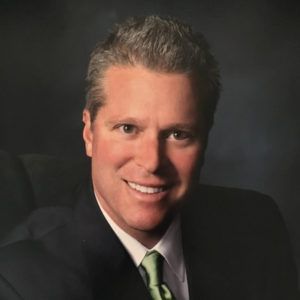
About Dr. Orlando
Carlo Orlando, MD. relocated to the Central Coast in 2018 following 23 years of orthopedic sports practice in Glendale, California. Dr. Orlando brings a wealth of experience to Central Coast Arthritis and Orthopedic Specialists, specializing in arthroscopic hip, knee, and shoulder surgeries and joint reconstruction.
Prior to moving to Templeton, Dr. Orlando was a 20-year volunteer attending orthopedic surgeon at the University of Southern California. He also spent four years as the fellowship director for the AOS orthopedic and sports fellowship program. Additionally, he served as as a preceptor for the USC physician assistant program for the last 10 years.
Resources
Office Hours
- Mon - Thu
- -
- Friday
- -
- Sat - Sun
- Closed
CLOSED FOR LUNCH 12:00-1:30 MON-THURS
Copyright 2024 Central Coast Arthritis and Orthopedic Specialists | Privacy Policy
